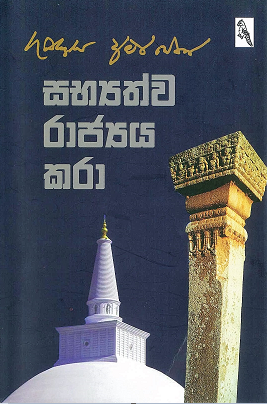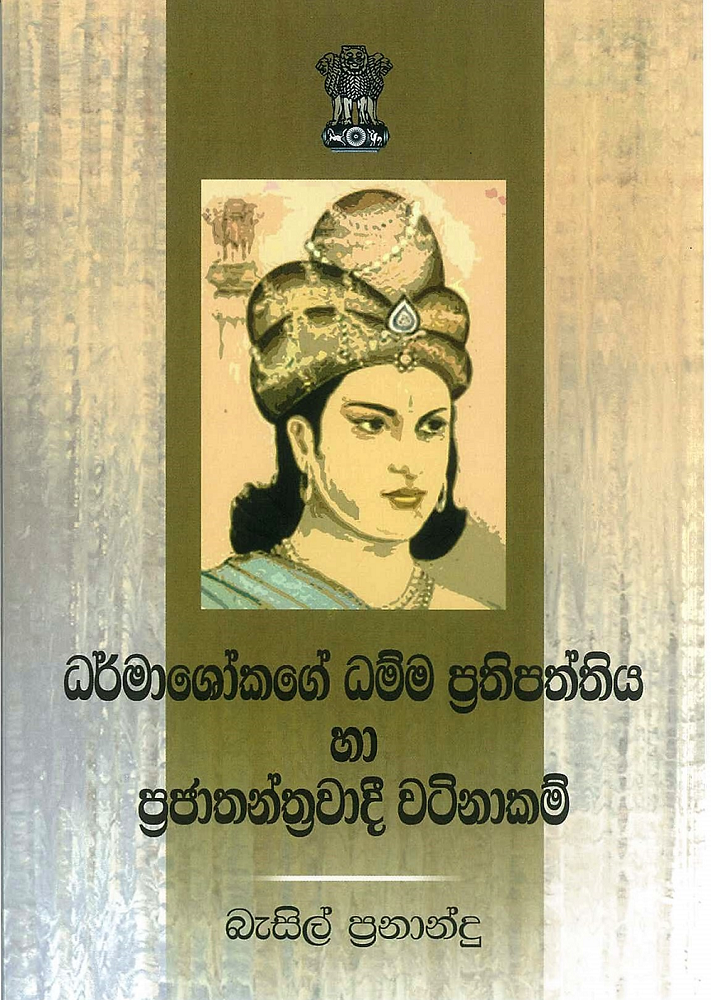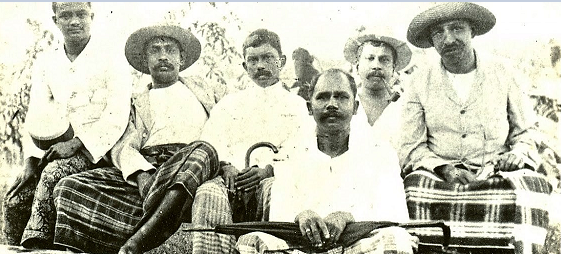By Basil Fernando
 Gunadasa Amarasekera has recently published a book entitled ‘Sabyathwa RajyakKara’ (Towards an Ethical State). At around the same time, I published a book entitled ‘Dharmasokage Dhamma Prathipaththtia sahaPrajatanthrawadi watinakama’ (The Policy of Dhamma of Dharmasoka and Democratic Values). In this article, I will try to show the similarities and differences in the ideas found in these two books. The basic ideas contained in Gunadasa Amarasekera’s book are as follows:
Gunadasa Amarasekera has recently published a book entitled ‘Sabyathwa RajyakKara’ (Towards an Ethical State). At around the same time, I published a book entitled ‘Dharmasokage Dhamma Prathipaththtia sahaPrajatanthrawadi watinakama’ (The Policy of Dhamma of Dharmasoka and Democratic Values). In this article, I will try to show the similarities and differences in the ideas found in these two books. The basic ideas contained in Gunadasa Amarasekera’s book are as follows:
An ethical state arose in the very early stages of Sri Lankan history and the basic character and outline of that state came with the arrival of Buddhism in Sri Lanka. Ven. Mahinda Thero also brought the Buddhist state structure, which was created by Emperor Asoka. In this context, we were able to develop our own ethical state – a Sinhala Buddhist state structure (my translation). According to Amarasekara, “[T]his ethical state remained unbroken up until the coming of European foreigners and, in particular, the British and the construction of a state structure of their own in Sri Lanka.“
According to Amarasekera, the state structure developed by the British is unsuitable for Sri Lanka; democracy, a system of parliament, and similar introductions by the British were based on their own nation state, which was developed in their country through several centuries. What is suitable for Sri Lanka is the rule by a single ruler, which was what prevailed during the time of the kings. On that basis, the executive presidential system is a suitable system for Sri Lanka. The movement led by Sobhitha Thero to abolish the Executive Presidency was, Amarasekara states, a misguided movement.
Amaraekera further states that Sri Lankans should go back to the ethical state created in the early part of their history. On that historical basis, S W R D Bandaranayake and the Sri Lanka Freedom Party represented governance in a way that was suitable to Sri Lanka. It was Chandrika Bandaranayake who distorted this. A person who once again represented leadership that is suitable for Sri Lanka was Mahinda Rajapakse.
The ideas that I have represented in my book: “The Policy of Dhamma of Dharmasoka and Democratic Values”, are as follows:
The development of an ethical state in Sri Lanka in the early part of its history took place on the basis of Dharmasoka’s policy of Dhamma. What this policy of Dhamma meant has been revealed in great detail through contemporary research. The great Indian historian Romila Thapar in her book “Asoka and the Decline of Mayuryas” has described in detail Asoka’s life and the policies he pursued. In this book, an entire chapter is devoted to describing his policy of Dhamma. The following quotes from this chapter throw light on the Dhamma of Asoka.
“ … The Dhamma of Asoka emerges as a way of life incorporating a number of ideals and practices. Abstinence from killing was an important principle, as also was the insistence of considerate family relationships and social relationships, whether these were between parents and children, elders and young people, friends, or various ideological sects. What would be regarded as a programme of social welfare, in twentieth-century parlance, such as providing medical facilities, good communications, and prohibiting useless expenditure on superstitions, was included. Moderation was the key-note of thought and action. Yet to begin with there was no attempt at coercion of any kind. Principles were suggested and it was left to the conscience of each individual to make a choice. In the later edicts we have noticed a marked change. In the Major Pillar Edicts, the advice becomes more abstract and is far less valuable than that given in the Major Rock Edicts.
“The author is so obsessed with the idea of the success of Dhamma, that the reality of the situation does not appear to register. In interpreting the term Dhamma we must beware of equating it with the Buddhist Dhamma, or any other accepted system which was called by this generic term. The true interpretation of Dhamma can only come about after a detailed analysis of who used the term and in what context. To suggest that all the Dharmas or Dhammas expressed in the literature and thought of ancient India are identical or nearly so, would be as foolhardy as to maintain that the meaning of the term Socialism used in any context in the past two hundred years has been identical or nearly so. Fortunately, there is no need to seek equations for the Dhamma of Moka as has been frequently done in the past. There is a large enough and reliable enough, body of literature in his own edicts, which provides the answer to the question, ‘What was the Dhamma of Asoka?’…”
The concept of Dharma used in the sense of ‘law and social order’ was by no means new to Mauryan India. Asoka, with the propagation of his Dhamma, made an attempt to humanize it and show that in fact what mattered most was virtuous behaviour. The ability to distinguish between virtuous and unvirtuous behaviour is what distinguishes man from the rest of creation, and the practice of virtue can be made common to all men. The Dhamma, embodying such behaviour, transcends all barriers of sec¬tarian belief. As we have said before, Dhamma was largely an ethical concept related to the individual in the context of his society. In the propagation of his Dhamma, Asoka was attempting to reform the narrow attitude of religious teaching, to protect the weak against the strong, and to promote throughout the empire a consciousness of social behaviour so broad in its scope that no cultural group could object to it.
What becomes starkly clear is that Dhammasoka’s policy of Dhamma was a complete rejection of the basic foundations of Brahminist philosophy. The Brahminist philosophy is also known as ‘Chathurvarnya’ philosophy. The division of people into four castes was an essential feature of Brahminist philosophy. In a historic speech made by Dr B R Ambedkar, which has been published under the title “Annihilation of Caste,” he explained that the caste system is a way of ordering society according to vedic doctrines. A better part of Dr Ambedkar’s life was devoted to resurrecting Buddhism in India, which had been wiped out from India around 8th Century A.D. He explained that the ideals of Buddhism are more suitable for a democracy where everyone would be treated equally and where social dynamism would be guaranteed; social mobility is completely prohibited under the caste system. Dr. Ambedkar was in charge of the Committee that drafted the Indian Constitution. That constitution is based on the principles of liberty, equality, and fraternity. In 1954, in a speech broadcast through the radio, Dr Ambedkar explained his own philosophy, which was based on the ideals of liberty equality and fraternity, was not borrowed from the French revolution but was derived from his Master, the Buddha. This short speech is worth quoting in full:
“My Personal Philosophy”
“Every man should have a philosophy of life, for everyone must have a standard by which to measure his conduct. And philosophy is nothing but a standard by which to measure.
“Negatively, I reject the Hindu social philosophy propounded in the Bhagvat Geeta based as it is, on the Triguna of the Sankhya philosophy which is in my judgment a cruel perversion of the philosophy of Kapila, and which had made the caste system and the system of graded inequality the law of Hindu social life.
“Positively, my social philosophy may be said to be enshrined in three words: liberty, equality and fraternity. Let no one, however, say that I have borrowed my philosophy from the French Revolution. I have not. My philosophy has roots in religion and not in political science. I have derived them from the teachings of my master, the Buddha. In his philosophy, liberty and equality had a place: but he added that unlimited liberty destroyed equality, and absolute equality leaves no room for liberty. In his philosophy, law had a place only as a safeguard against the breaches of liberty and equality; but he did not believe that law could be a guarantee for breaches of liberty or equality. He gave the highest place to fraternity as the only real safeguard against the denial of liberty or equality or fraternity which was another name for brotherhood or humanity, which was again another name for religion.
“Law is secular, which anybody may break while fraternity or religion is sacred which everybody must respect. My philosophy has a mission. I have to do the work of conversion: for, I have to make the followers of Triguna theory to give it up and accept mine. Indians today are governed by two different ideologies. Their political ideal set out in the preamble to the Constitution affirms a life of liberty, equality and fraternity. Their social ideal embodied in their religion, denies them.”
In considering Dhammasoka’s policy of Dhamma, it is also necessary to emphasize that it meant a rejection of the policy of disproportionate punishment, which is an essential aspect of Brahminism. This simply meant that lower castes should face extremely harsh punishments for any transgression and that there should be no punishments, or only very light punishments, for the Brahmins.
Dr. D R Nagaraj, in “The Flaming Feet and Other Essays – The Dalit Movement in India”, explains how this idea of disproportionate punishment is practiced against the lower caste people, even in modern India.
“It all began with a Dalit’s act of stealing corn, on a rainy day in August 1988, from a field close by. The guilty Dalit owned up to the theft and accepted that he would have to make amends. The proper legal way was to hand him over to the appropriate agencies of the state. But upper-caste villagers literally took the law into their own hands and made the thief and his companions eat human excreta. Another example is: Another similar episode in 1987 at Bidaralli, a village in Bleguam district, reveals one more facet of the problem. A violent clash took place in this village on the issue of a Dalit boy’s act of ‘teasing’ an upper-class girl. His crime was that he had ‘pulled a girl’, but the village societies retaliatory measure was to impost a total boycott of Dalits. This was so severe that the Dalits could not reach the village’s drinking water sources. One can cite hundreds of such — and much more cruel – instances”.
“The kind of society that grows out of the pursuit of Brahminical idea of caste is escribe in an award winning Aravind Adiga, in his ManBooker Prize-winning novel, The White Tiger, explains thus, “The greatest thing to come out of this country in the ten thousand years of its history is the Rooster Coop. Go to Old Delhi, behind the Jama Masjid, and look at the way they keep chickens there in the market. Hundreds of pale hens and brightly coloured roosters, stuffed tightly into wire-mesh cages, packed as tightly as worms in a belly, pecking each other and shitting on each other, jostling just for breathing space; the whole cage giving off a horrible stench — the stench of terrified, feathered flesh. On the wooden desk above this coop sits a grinning young butcher, showing off the flesh and organs of a recently choppedup chicken, still oleaginous with a coating of dark blood. The roosters in the coop smell the blood from above. They see the organs of their brothers lying around them. They know they’re next. Yet they do not rebel. They do not try to get out of the coop. The very same thing is done with human beings in this country.”
The change that took place around 800 AD
The ethical state that was originally established underwent a great transformation for the worse when Indian philosopher Adi Sankar’s philosophy of Maya – illusion – was introduced to Sri Lanka by the Indian invaders, and also by the introduction of the distinction of people on the basis of Kulina (upper caste) and Kulahina(lower caste). This distinction became a central part of social divisions inside both Sinhalese and the Tamil communities ever since. The adoption of the philosophy of Maya, along with the caste division, was bringing the Chathurvarnya philosophy into Sri Lanka, which was the very opposite of Asoka’s Dhamma philosophy and the Buddhist teaching itself.
This was not a minor transformation; it was a replacement of the ideals on which the original ethical state stood with a completely opposite set of ideals.
Despite reforms brought about by kings like Parakramabahu and Wijayabahu, there was no change or rejection of the caste system. The caste system was so powerful that even when the Buddhist monkhood was restored, through the help of monks from Thailand and Burma, the Sri Lankan monks themselves adopted the caste system in setting up their religious orders.
That was the situation that prevailed in Sri Lanka when the European powers arrived and when the British took over the island in 1815. Perhaps, had it not been due to the deep divisions of people into kulina and kulahina, there would have been a far greater unity among the people and they might have been able to resist these foreign powers.
The British did not directly abolish the distinction between kulina and kulahina, though some of their reforms did affect the caste system indirectly. For example, when the policing system was established several complaints were received about the prevailing practice of killing any woman who married outside their caste. A C Dep in his book History of the Ceylon Police (Volume I) describes a practice that came to the notice of the police: the elders of a low caste had the obligation to kill a woman of their caste who may have developed a love relationship with a man from a higher caste. In terms of the use of disproportionate punishment, the manner in which Sri Lankan society was organized was no different to Aravind Adiga’s description in the above quote.
Independence
 The basic structure of the constitution adopted by Sri Lanka at its independence was inkeeping with the principles of liberty, equality and fraternity. That basic structure was not just a British idea, it was adopted by many countries in developing their constitutions when they rejected monarchy and developed a state where people themselves are free to elect their own governments.
The basic structure of the constitution adopted by Sri Lanka at its independence was inkeeping with the principles of liberty, equality and fraternity. That basic structure was not just a British idea, it was adopted by many countries in developing their constitutions when they rejected monarchy and developed a state where people themselves are free to elect their own governments.
It is this model that Gunadasa Amarasekera sees as an unsuitable model for Sri Lanka. He prefers one man’s rule as that was how the kings ruled Sri Lanka. What he rejects is the most basic idea of the abolition of the monarchy, which is in conflict with the basic ideas of liberty, equality and fraternity. These principles are the ideals associated with any modern society. Monarchies that remain in developed countries are purely ceremonial and are not used for actual governance.
Amarasekera does not mention anything in his book about the way science has changed the way we think about almost all areas of life and society. The spirit of criticism and the reliance on critical thought led to the abolition of rule through monarchies and resulted in the establishment of democratic governments.
Amarasekara’s claim that S W R D Bandaranayake and Mahinda Rajapakse represent the ideals of the ethical state developed in the early part of Sri Lanka’s history is simply ridiculous. It is in fact a slur on the great ideals brought through Asoka’s philosophy on Dhamma.
The fact that the political institutions of Sri Lanka have faced a great crisis is of course obvious. That was more due to the mentalities of Sri Lankan leaders, whose minds have been molded by about 1200 years history: the philosophy of Maya and social organization on the basis of caste discrimination. These local rulers were mostly exploiters of the local rural masses, and their ideas of social control were based on their own lifestyles. They were not willing to administer a state based on equality before the law. In fact, for them, law itself was an obstacle to the way they wanted to rule. They made changes that ignored even the most basic principles accepted as checks and balances against the abuse of power. The Executive Presidency, in fact, was the rejection of the idea of the need for law. When a ruler is able to ignore the law, then, naturally, chaos is the result. Asoka’s philosophy of Dhamma meant adherence to strict legal principles of the time. It is this that is being symbolized by the Dhamma Chakra, which is a symbol of the Asokan ideals.
If Amarasekera’s ideas are to be practiced, the chaos in Sri Lanka will only worsen. However, if serious studies are made on Dharmasoka’s policy on Dhamma, it could help in the development of democratic institutions that could contribute to the welfare of all Sri Lankans.